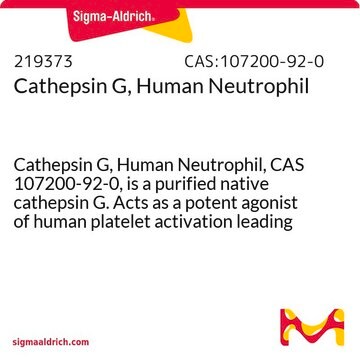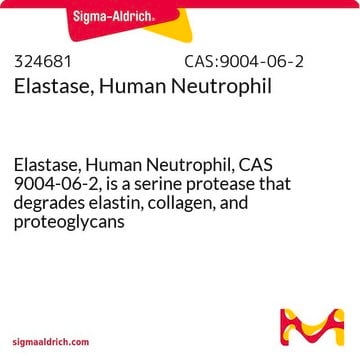MABT1240
Anti-Cathepsin G Antibody, clone AHN-11, Ascites Free
clone AHN-11, from mouse
Sinônimo(s):
Cathepsin G, CatG, CG
About This Item
Produtos recomendados
fonte biológica
mouse
Nível de qualidade
forma do anticorpo
purified immunoglobulin
tipo de produto de anticorpo
primary antibodies
clone
AHN-11, monoclonal
reatividade de espécies
human
técnica(s)
ELISA: suitable
immunocytochemistry: suitable
radioimmunoassay: suitable
western blot: suitable
Isotipo
IgG2aκ
nº de adesão NCBI
nº de adesão UniProt
modificação pós-traducional do alvo
unmodified
Informações sobre genes
human ... CTSG(1511)
Descrição geral
Especificidade
Imunogênio
Aplicação
Cell Structure
Inflammation & Autoimmune Mechanisms
Immunocytochemistry Analysis: Clone AHN-11 hybridoma culture supernatant immunostained ethanol-fixed human neutrophils, but not other peripheral blood cells, including platelets, lymphocytes, and eosinophils. Faint immunostaining of some monocytes was occasionally detected (Skubitz, K.M., et al. (1989). J. Leukoc. Biol. 46(2):109-118).
ELISA Analysis: A representative lot captured cathepsin G from human neutrophil granule extract. The captured cathepsin G served to detect the presence of serum cathepsin G autoantibody levels in patients serum samples (Ellerbroek, P.M., et al. (1994). J. Clin. Pathol. 47(3):257-262).
Radioimmunoassay Analysis: Clone AHN-11 hybridoma culture supernatant bound to well surface coated with dried human neutrophils, but not platelets or erythrocytes by solid-phase radioimmunoassay (Skubitz, K.M., et al. (1989). J. Leukoc. Biol. 46(2):109-118).
Radioimmunoassay Analysis: Clone AHN-11 hybridoma culture supernatant bound to well surface coated with content of primary granule, but not secondary granule, plasma membrane, or cytoplasm fraction from neutrophils by solid-phase radioimmunoassay (Skubitz, K.M., et al. (1989). J. Leukoc. Biol. 46(2):109-118).
Radioimmunoassay Analysis: Clone AHN-11 hybridoma culture supernatant reacted with purified human cathepsin G, but not elastase, EPO, esterase N, proteinase 3, plamin, kallidrein, lactoferrin, MBP, or thrombin by solid-phase radioimmunoassay (Skubitz, K.M., et al. (1989). J. Leukoc. Biol. 46(2):109-118).
Qualidade
Immunocytochemistry Analysis: A 1:200 dilution of this antibody detected Cathepsin G in HL60 human promyelocytic leukemia cells.
Descrição-alvo
Ligação
forma física
Armazenamento e estabilidade
Outras notas
Exoneração de responsabilidade
Not finding the right product?
Try our Ferramenta de seleção de produtos.
Código de classe de armazenamento
12 - Non Combustible Liquids
Classe de risco de água (WGK)
WGK 1
Ponto de fulgor (°F)
Not applicable
Ponto de fulgor (°C)
Not applicable
Certificados de análise (COA)
Busque Certificados de análise (COA) digitando o Número do Lote do produto. Os números de lote e remessa podem ser encontrados no rótulo de um produto após a palavra “Lot” ou “Batch”.
Já possui este produto?
Encontre a documentação dos produtos que você adquiriu recentemente na biblioteca de documentos.
Nossa equipe de cientistas tem experiência em todas as áreas de pesquisa, incluindo Life Sciences, ciência de materiais, síntese química, cromatografia, química analítica e muitas outras.
Entre em contato com a assistência técnica








